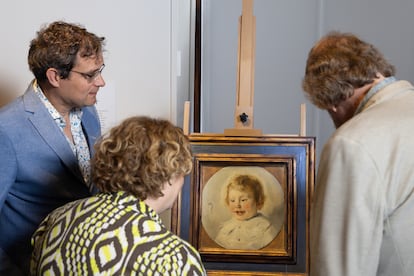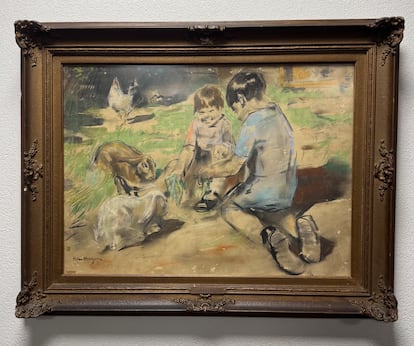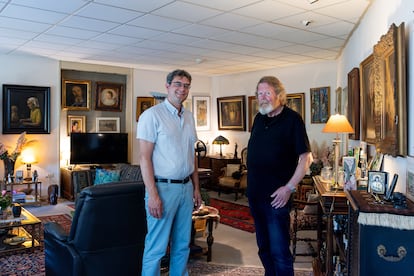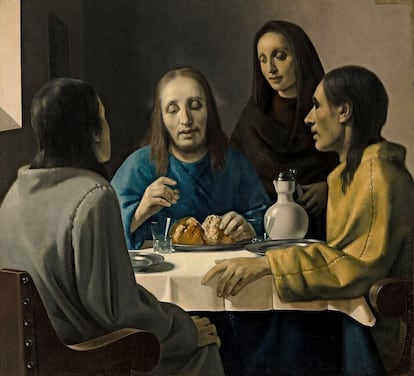In 1947, the Second World War has recently finished, a strange trial took place in the Netherlands. The defendant bench occupied him Han Meegeren, a 58 -year -old painter accused of looting national cultural goods. The sale of the picture was attributed Christ and the adulterous woman, of the gold century Johannes Vermeer, nothing less than the Nazi Hermann Goering, supreme commander of the German Air Force. But it was not a case of collaboration. The defendant admitted to being the true author of the fabric and assured that the titled The disciples in Emaus, Exposed at the Boijmans Van Beuningen Museum, Róterdam, It was also his and not to seemeer. He affirmed, even having executed one more handful. Condemned by fraud and deceased shortly after, his hometown, Developor, prepares a museum to show from 2026 his works: those who carry their authentic and several false signature.
The exhibition, permanently, will mark the return home of the most famous imposter in the history of Dutch art, who wanted to succeed in his own but his classic style disregarded among the artistic avant -garde of the twentieth century. A man who got carried away by greed, and whose national socialist sympathies during the German occupation of the Netherlands are still a reason for study. “Art forms are usually complicated and unhappy people,” he says, in an email, the American Edward Dolnick, author of The Forger´s Spell (The counterfeit spell). The book covers the almost perfect crime committed by Van Meegeren, and the writer remembers in his message that “it is not good for the soul that people pass in front of your work without paying attention when it bears your name, but that they are speechless when he is from another person.” At the same time, Dolnick warns that “greed was a stronger motivation than injured pride.”
Han Van Meegeren was born in 1889 in a family of deep Catholic devotion. His father did not want him to be an artist and forced him to study architecture. He also forced him to write hundreds of times: “I don’t know anything, I’m nothing, I’m not able to.” The boy enrolled in the Higher Technical School of Delft between 1907 and 1913, and although he approved the exams easily, he did not appear to the final test. Bartus Korteling, a friend painter, instructed him in the style of the teachers of the seventeenth century, and when he won a gold medal of the university with an oil inside a church, the luck was thrown.
As a professional painter, he was popular and with a certain sales success. “He lacked the recognition of criticism, but it was not a failure,” says Ewout van der Horst, director of Develo Verhaal, the foundation that promotes the conservation of the city’s cultural heritage, east of the country. He says that Meegeren “had many expenses due to his love for luxury, and we wish to tell the story of a man tormented through his work.” This institution has bought a thirty of its paintings from a local collector, called Theo Bakker, for the exhibition. Bakker, who had the house lined with Van Meegerenshe does believe that he falsified “because critics called their work of decorative and worthless,” he says.
Divorced from his first wife, and with two children, the artist settled in 1932 with his second wife in southern France. There he experienced for years with white lead, indigo, cinabrio and lapislázuli until he achieved the proper mixture. Two things were missing: a 17th century canvas and something for pigments to seem old. He resolved the first buying an authentic cloth of the time, which scratched with pumice to erase the original. Then it occurred to Baquelita to the paint, a synthetic resin that harden it as when it dries over time.

Once the picture was finished, I put it in an oven at about 100 degrees Celsius and then rolled it on a cylinder. Thus the cracking was achieved, the cracks that appear on the canvases due to aging, and then filled with Chinese ink. He ended with opaque varnish. He first executed a work in the style of the flamenco painter Frans Hals, but was removed from a false auction without his authorship. He also made a couple of tests in the style of Vermeer, although he did not sell them. In 1936 it ended The disciples in Emaus. It is the evangelical passage in which the risen Christ appears on their way to the village of the same name. The deception exceeded their expectations and there was no reversal.
In 1937, The disciples in Emaus He arrived through an intermediary to Abraham Bredius, the most respected expert of his time. As soon as he described as Vermeer’s masterpiece, a struggle broke out for buying it. The sale price was 520,000 Florines, and in the end it was acquired by a rich shipowner who donated him to Boijmans Van Beuningen, reports the museum. Part of Van Meegere’s success is explained because he captured the environment conducive to the appearance of an early table of Vermeer, generated in the Netherlands by art historians themselves. These argued that he must have painted religious issues when he was not as recognizable as in the famous The young woman of the pearl. Did the scientific controls fail?

It is a paradox that Edward Dolnick explains like this: “Experts (in art) and scientists usually come from different worlds and distrust each other.” He adds that, in this case, there was a strong group element and “once the critics realized the falsification, most followed their example.” Van Meegeren remained in the shadow with the sale, became a millionaire and no longer stopped falsifying until, in 1942, Christ and the adulteress He arrived at Hermann Goering, the Nazi hierarchy. It was another assumption of Vermeer, and in the middle of the war it was difficult to compare it with the originals. Goering paid 1.6 million florines and thought they had a jewel.
Although Meegeren are not dealing with Goering, his alleged national socialist affinities “are very bad politically,” according to Dolnick. For his part, in his book The man who made Vermeers (The man who made Vermeers), the American historian of art Jonathan López argues that the Dutch was a scammer and an opportunist. He writes that he needed money and took advantage of the Nazi occupation, although he sympathized with this ideology. As in the German bureaucracy everything was pointed out, when the allied forces found Christ and the adulteress In the Austrian Castle of Fishhorn, they pulled the thread of marching and messengers until they reached Van Meegeren. It was the beginning of the end, but there was a spectacular turn.

To avoid being accused of betrayal of the homeland, the painter had to recognize in 1945 that he was a falsifier. They did not believe him, and then he declared before the judges that he could prove it. The court accepted the challenge and conditioned an apartment in Amsterdam to paint a picture like Vermeer. He made in public Jesus and write them in the temple, And the trial opened in October 1947. The audiences had an international echo, especially since he defended himself saying that the important thing was that he had deceived Goering: the enemy. The image of the mockery to the occupant fell among his compatriots and became almost a hero. Sentenced to a year in prison, he died that same December with problems of alcohol addiction, tobacco and morphine. “Van Meegeren is an important figure for what he tells us about credulity and scammers,” says Edward Dolnick. What if he also fed the desire that there are still hidden treasures of art?

